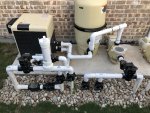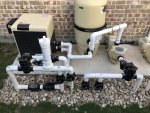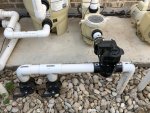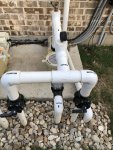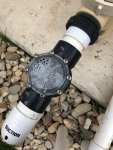Problem
My pool loses chlorine over the span of 8-10 days. The pool builder doesn't know why. I have to bleed air out of my system ever 7 days to keep chlorine from getting too low. They think it may have something to do with the way the system is plumbed.
Steps Followed (reproducible)
See attached. One thing that really confuses me is the way it's plumbed on the return side. The pool builder owner doesn't understand why it was done this way on my pool (but he's not a plumber), and he said two other pools he built recently (which also have a spa) were not plumbed exactly like this.
Questions
My pool loses chlorine over the span of 8-10 days. The pool builder doesn't know why. I have to bleed air out of my system ever 7 days to keep chlorine from getting too low. They think it may have something to do with the way the system is plumbed.
Steps Followed (reproducible)
- Filled the chlorinator with 9 new tabs
- Bled the system of air (turn pump on high; let the water spill over the top of the chlorinator; put the lid on the chlorinator)
- Left the system running (switching between pool and spa once each per day)
- Never turned the system off
- Checked the water every 2 days
- The reading of chlorine was strong for the first few days
- The chlorinator dial is turned to fully open (level 5)
- I did not change any filters; no returns or drains were exposed to air
- I have a no-main-drain pool
- My equipment pad is higher than the pool
- I have a separate pump for my water features (fountain and bubbler; note that, according to the plumber, these take a minute or more to actually get water flow because the equipment pad is higher than the pool, and so water drains out when they are turned off).
See attached. One thing that really confuses me is the way it's plumbed on the return side. The pool builder owner doesn't understand why it was done this way on my pool (but he's not a plumber), and he said two other pools he built recently (which also have a spa) were not plumbed exactly like this.
Questions
- Why is there a pipe connecting the pool and spa return lines?
- Is it bad that the equipment pad is higher than the pool? What other problems could result from this?
- What are the other possible reasons could cause air to accumulate in the chlorinator?
- Even though I don't have any "main drains," I do have suction around the sides of the pool. Should those have been separated from the skimmers when going into the pump?
- When I open the lid to the chlorinator, the water drains entirely from the chlorinator (when the pump is on low). However, if I turn the pump to high, water fills up the chlorinator and spills out the top. Why, when running in low speed, wouldn't at least some of the water stay in the chlorinator?
Attachments
Last edited:


